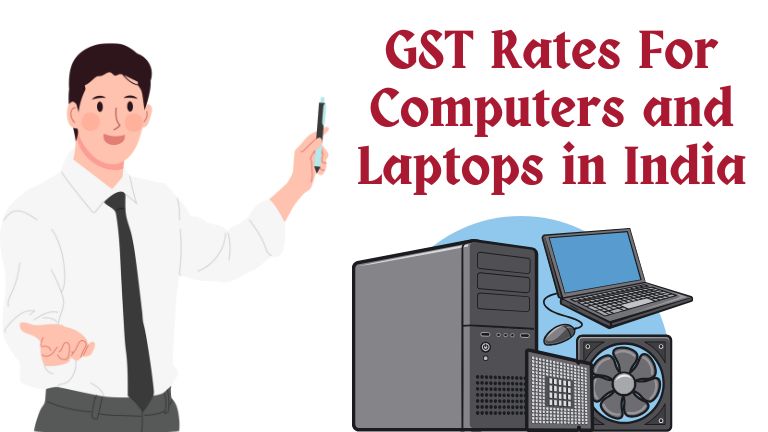The Goods and Services Tax (GST) regime, introduced in India
in 2017, replaced multiple indirect taxes with a single tax structure. The GST
is designed to streamline the country's tax system, simplify the process for
businesses, and ensure a uniform taxation policy across states. However, the
tax rate varies depending on the category of goods and services. When it comes
to technology products like computers and laptops, the GST rate is an important
factor affecting both businesses and consumers alike. In this article, we will
take a detailed look at the GST rates for computers and laptops, the factors
influencing these rates, and how they impact the Indian market.
Understanding the GST
Slab System
Under GST, goods and services are classified into different
tax slabs—0%, 5%, 12%, 18%, and 28%. The classification depends on the nature
of the product or service, with essential items often taxed at lower rates,
while luxury items or those considered non-essential are taxed at higher rates.
Electronic items such as computers and laptops fall within the 18% GST slab,
which is neither the lowest nor the highest bracket. This rate is meant to
strike a balance between encouraging the use of technology and collecting
revenue for the government.
GST Rate on Computers
and Laptops
As of the latest updates in 2024, the GST rate applicable to
computers and laptops is 18%. This rate applies uniformly across different
types of computers, laptops, and their accessories, irrespective of whether
they are used for personal, educational, or business purposes. The
classification includes:
- Desktops
- Laptops
- Monitors (above a certain size)
- Peripheral devices like printers and keyboards
- Other hardware components
While 18% may seem steep for some consumers, it is still
lower compared to luxury items, which attract a 28% tax. The government has
chosen this rate, keeping in mind that computers and laptops are increasingly
essential in the digital economy but are not classified as everyday consumer
necessities like food items or essential medicines, which are taxed at lower
rates or exempt altogether.
Input Tax Credit (ITC) for Businesses
One of the benefits of GST is the provision of Input Tax
Credit (ITC). ITC allows businesses to claim credit for the tax paid on inputs
(in this case, computers and laptops) used to produce goods or services. This
is a significant advantage for companies purchasing computers and laptops for
business use, as it reduces the overall tax burden.
For example, if a business purchases laptops for office use
and incurs an 18% GST on the purchase, the company can claim this amount as an
input tax credit. When the business sells its goods or services and collects
GST from customers, it can offset the tax paid on laptops against the tax it
owes, thereby lowering its tax liability.
Impact on Consumers
For individual consumers, the GST rate directly affects the
cost of purchasing computers and laptops. Since the 18% tax is included in the final
price of the product, a laptop that costs ?50,000 before tax will end up
costing ?59,000 after adding the GST of ?9,000.
Price Breakdown
Example:
- Base price of laptop: ?50,000
- GST at 18%: ?9,000
- Total cost: ?59,000
This increase in price can make computers and laptops less
affordable, particularly for students or those from low-income households.
However, during festive seasons or promotional offers, many retailers absorb
part of the GST to offer attractive discounts, making technology more accessible
to the general public.
How GST Affects the Import of Computers and Laptops
India imports a significant number of computers, laptops,
and related accessories from countries like China, Taiwan, and the USA. The GST
on imported goods is applied at the same 18% rate under the Integrated Goods
and Services Tax (IGST). When importing computers or laptops, businesses need
to pay the IGST, which can later be claimed as input tax credit if the imported
goods are used for business purposes.
Apart from GST, customs duty is also levied on imported
goods. The customs duty rate can vary depending on the type of product and the
country of origin. For example, under trade agreements, some countries enjoy
lower import duties, which can help reduce the overall cost of importing
technology products.
GST on Second-hand or Refurbished Computers
and Laptops
For second-hand or refurbished computers and laptops, the
GST rules are a bit different. The government allows a reduced tax rate for
such products under the Margin Scheme, which taxes only the profit margin on
the sale of used goods rather than the full value. For example, if a business
purchases a used laptop for ?20,000 and sells it for ?25,000, the GST is
charged only on the ?5,000 profit margin, rather than the entire selling price
of ?25,000.
This scheme benefits the resale market for electronics and
makes second-hand or refurbished computers more affordable for consumers.
GST on Computer Accessories and Software
Computer accessories such as keyboards, mouse devices, and
printers, as well as external storage devices, also attract an 18% GST.
However, it is worth noting that software products come under different tax
rates based on whether they are sold as goods or services.
- Packaged software (off-the-shelf) is treated as
goods and attracts an 18% GST rate.
- Customized software or software delivered as a
service (SaaS) is classified under services and is taxed at 18%.
This classification ensures that different types of software
are treated appropriately under the GST regime.
The Future of GST on Computers and Laptops
The GST Council regularly reviews tax rates and makes
adjustments based on economic needs and technological advancements. There have
been discussions about lowering the GST on computers and laptops to promote
digital education and the wider adoption of technology, especially in rural
areas. However, as of now, the 18% rate remains in effect.
Several industry bodies have advocated for a reduction in
the GST rate on computers, especially for students and educational
institutions, arguing that a lower tax could help bridge the digital divide in
India. With increasing demand for online education, remote work, and digital
infrastructure, any reduction in the GST rate could significantly impact both consumers
and the tech industry.
Conclusion
The GST rate of 18% on computers and laptops is part of a
balanced approach by the Indian government to tax technology products. While
this rate increases the cost of devices for individual consumers, it also allows
businesses to claim input tax credits, thereby reducing their tax liabilities.
The import of computers and laptops also attracts IGST, though businesses can
offset this cost through ITC.
Looking forward, any reduction in GST rates for computers
could help drive greater technology adoption, particularly in rural areas and
among students. For now, the 18% GST rate stands as an essential element of the
taxation system, contributing to government revenues while aiming to keep tech
products within reach for most Indians.

